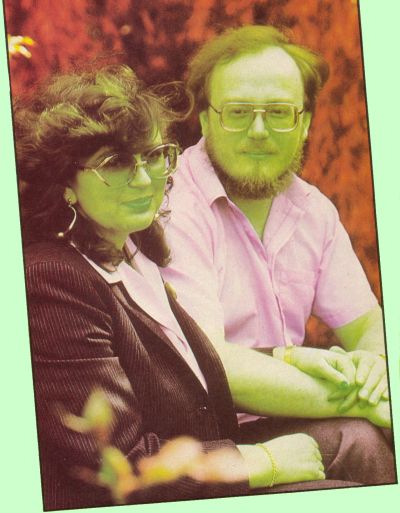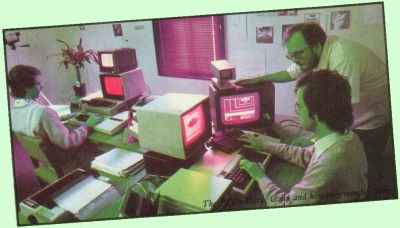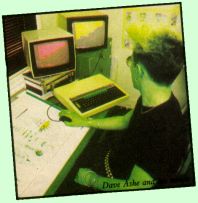| Hit Squad |

Jan and John Peel: Turkey busters |
Can the ghost of Christmas Past be laid to rest? Bill Scolding meets the exorcists
LEAD-BLACK clouds are massing in the east as we draw up outside the innocent looking offices of a suburban building society. I feel the hairs rise on the nape of my neck.
Through a shabby unmarked door, down an unlit alleyway and up the creaky staircase. All too quickly we are ushered into the presence of the Peels, the obsessive genius and his insanely loyal wife, who together created the infamous House of Legend and unleashed its power upon an unsuspecting world.
John Peel - techno-freak and dedicated eccentric - rises to greet us. His eyes lurk behind glasses thick as the bottoms of milk bottles, his chin boasts a fluff of a beard, his head a receding wisp of hair. He talks and smokes incessantly.
Jan Peel, long dark hair and a wide grin, keeps John in check, curbing the excesses of his indiscriminating gossip. As managing director she is very much in control, coping with administration, sales and generally maintaining contact with the real world; while John, head of software, indulges in the flights of fantasy which eventually see the light of day as Legend games.
Pleasantries over, Peel is immediately on the attack. "I have to tell you that I was Very Angry when I saw your little piece in the May issue."
Oh God, Gremlin's got it wrong again. Nothing else for it but to brave the storm ... "All that rubbish about hiring a country mansion for the programmers," Peel continues. "Totally untrue." He waves his arms about, taking in the small office, the cartons stacked against the wall, the overflowing desks and ashtrays.
"We didn't set out to con or hype anyone with TGSR." TGSR - The Great Space Race, a game you didn't so much play as sit back while it played with itself. Launched just before Christmas, it got a thumbs down from the press, bombed in the shops and left distributors howling.
"The programming team ran for cover. We brought in a new team which spent three weeks of sleepless nights trying to get the shambles working for the deadline," Peel explains. "But we let our main distributors see it, giving them the chance to cancel or reduce their orders. They were greedy and thought the game would sell anyway.
"Now we're offering Komplex at reduced price to all those kids who bought TGSR and weren't happy with it. And we've done deals to bail out distributors of all unsold copies. We didn't have to, but we wanted to regain credibility. We lost over £200,000 on the game." On the office wall a TGSR poster looks down, the curse which might have brought about the fall of the House of Legend.
Peel lurches to his feet. "Come on, let's see what Software is doing." Up another flight of stairs to the garret of Dave Ashe, artist, punk. All in black, with studded black belt, black and yellow hair, Ashe looks like a healthy Ian Dury. He designs all the on-screen graphics, the advertisements, posters and logos, although Jan Peel retains close creative control. Complicated geometric shapes spiral across his sketch pads and mouse-driven design screens, the rough layouts for the Komplex trilogy.
Ashe creates the images on a customised BBC and they are then transferred, via heavily expanded BBCs used by the programmers next door, to the Spectrums and Commodores. Peel enthuses about the detail of the graphics. "A full set of frames, for one rotating object moving towards you, can take 24 frames or more depending on flicker and over three days to draw."
At present the team is working on Komplex City, part two of the trilogy, due to be on sale at the end of June. "Each game is complementary to the others, though different," says Peel. "In a sense Komplex City should have been launched first. It's the fastest of the games and involves less mapmaking."
Nevertheless, the program has the potential for a mind-boggling quantity of maps, running into trillions. Peel explains, "Each map has a 12-character name, and as there are 37 possible characters - including the alphabet and numerals - then there are 6,500,000,000,000,000,000 maps which can be generated." Hmm.

The PPC: Dave, Colin and honorary member John |
We move into the programming den, known as the PPC - the Perverts and Pillocks Club,- where Colin Foster and Dave Ebsworth sweat out their days over the keyboards.
Ebsworth is fresh-faced and straight from school; Colin, older but just as clean, with an MSc in concurrent operating systems. Like Ashe, both sport Komplex T-shirts. For our benefit, or is it a house rule?
Part of Komplex City is up on the monitor; waves of 'flyngs' - PPC verbal shorthand for flying things hurtle down wireframe tunnels. Every now and then a docking screen appears, 'an assortment of interesting gratuitous garbage', as Peel puts it, although it is not gratuitous at all. It can replenish your energy levels and hyperspace drive, or deplete them further if used incorrectly.
Docking in Komplex City is easier than in Komplex, apparently due to criticism that it was too difficult in the earlier game. Other improvements include a real-time clock. A scrolling database keeps track of where your targets are in the labyrinth.
The shelves around the room are crowded with boxes of discs and ring binders, fat with code listings - the debris of The Great Space Race. "Over £1000 of discs were used," moans Peel. "Most of it had to be junked."
Was the game too ambitious? Colin Foster pauses, creating the impression that he is considering this for the first time. "From what I've seen the programmers weren't up to it." Peel has no such reservations. Brandishing a carton he exclaims, "That's how professional they were. They were using microdrives!"

Dave Ashe and his mouse |
Will the ghost of TGSR ever be laid to rest? Peel puts on a brave face. "As a result of TGSR we came up with the philosophy of visible development. Every day, if not every hour, progress can be seen." In other words, you don't leave it until the last minute to discover you've hatched a turkey.
The Legend offices are crammed full of hardware. Not just keyboards, drives and screens, but extraneous equipment too - miniature TVs, complicated cameras. Spectrums are in abundance - "They tend to break down a lot," mutters Peel - but not an Amstrad or MSX to be seen.
"We're not bothering with them," says Peel. "It is mostly second league software houses which are jumping for the Amstrad because they can't compete with the first leaguers on the Commodore and Spectrum. We've had Amstrad around here pestering us to do things. We'd license products to them for conversion but for us it's not economic."
And the QL? "I wouldn't touch it, mainly because I don't know anybody who's got one," Peel says and then adds, "Oh, except one of the TGSR programmers - which says a lot."
We leave the black-garbed PPC and go for lunch. The sky too is black now and the air is heavy.
Several glasses of wine later we are treated to a potted history of the Peels. In the years BC - Before Computers - John Peel hacked it as a freelance hi-fi journalist. "Faced with my 92nd article on how to choose a record deck I realised I was burnt out," says Peel.
Was he ever confused with the well known disc jockey? "Oh yes, got lots of fan mail - and some very interesting phone calls. One magazine had the bright idea of a 'John Peel meets John Peel' article. I met the guy, didn't get on with him, so we got drunk instead. By the time the photographer arrived we were plastered. Worst photographs ever taken."
Peel's first computer was a CBM 100 followed by a UK 101. When Casio launched its handheld micro Peel produced the English manual.
Peel formed MiCROL in September 1981; it was a bread and butter operation, selling spreadsheets and databases for portable computers. "We knew the Spectrum was coming, and the first MiCROL Spectrum ads appeared the week of the press launch. We didn't realise games were going to be big but around Christmas '82, when Quicksilva was advertising its games, we knew it was the time for games. We decided to go for an adventure as the only professional adventure at that time was The Hobbit.
"Valhalla was masterminded from a one-bedroom flat in Purley," Peel continues. "It took three man years to write, starting in March '83, and was ready in October. We didn't try to contact any distributors; they had to work hard to find us."
Jan Peel designed the adverts, wrote the manual and did the imaging for the characters in Valhalla. An ex-nurse, working in a boys' school, she met John Peel through an ad placed by her friends in the lonely hearts' pages of Time Out. They arranged to meet; Jan would be driving her red Mini, John would be waiting on the corner. "I got in, talked to the lady. We got on fine," Peel laughs. "Trouble was, it was the wrong red Mini ... Jan had got lost."
And now they drive a Porsche.
What do they feel of recent animated adventures, other computer movies? "We coined the phrase 'computer movie'," says Peel. "Imitation is the sincerest form of flattery. There are some products which command real respect, like Tir Na Nog. I greatly respect Ultimate's work. I thought I was going to like Skool Daze, but it was too complicated."
Jan Peel agrees. "It had great detail. I look at the characters, how they move. But," she confesses, "I hate most games. So many are too difficult to get into. Strangeloop is a good example of that type of game."
"Perhaps Komplex is too," adds Peel. "It's difficult striking a balance between the learning curve and game richness. "
What about Valhalla 2? When will that be released? Peel is cagey. "The true follow-up will come later in the year - another computer movie. " Will it include icons? Peel dictates slowly, "You can say, 'From what Peel said I suspect that it is likely that Valhalla 2 will consist of mixed icons and text.'" Thank you, John.
There is a sudden crack of thunder and a flash of lightning is reflected in Peel's glasses. "Right at this minute," he intones, "I can tell you what my team is doing. They're furiously making back-up copies to avoid mains glitches getting through our power smoothers."
Now there is a wall of rain outside. The conversation grows darker, and Peel holds forth on the evils of designer drugs and Santa Claus politics. Drugs form the background to The Novel he is writing, an apocalyptic vision of the future about which, after heavy hints from Jan Peel, he is unnaturally reticent. The rain pours down.
We leave the Peels and their haunted house in a hot black summer storm. The PPC are still beavering away over their machines, Dave the punk is drawing cabbalistic signs with his mouse, John Peel is wandering about in a wreath of cigarette smoke, the invisible albatross of The Great Space Race about his neck, and Jan Peel is smiling, in control. The Legend goes on ...